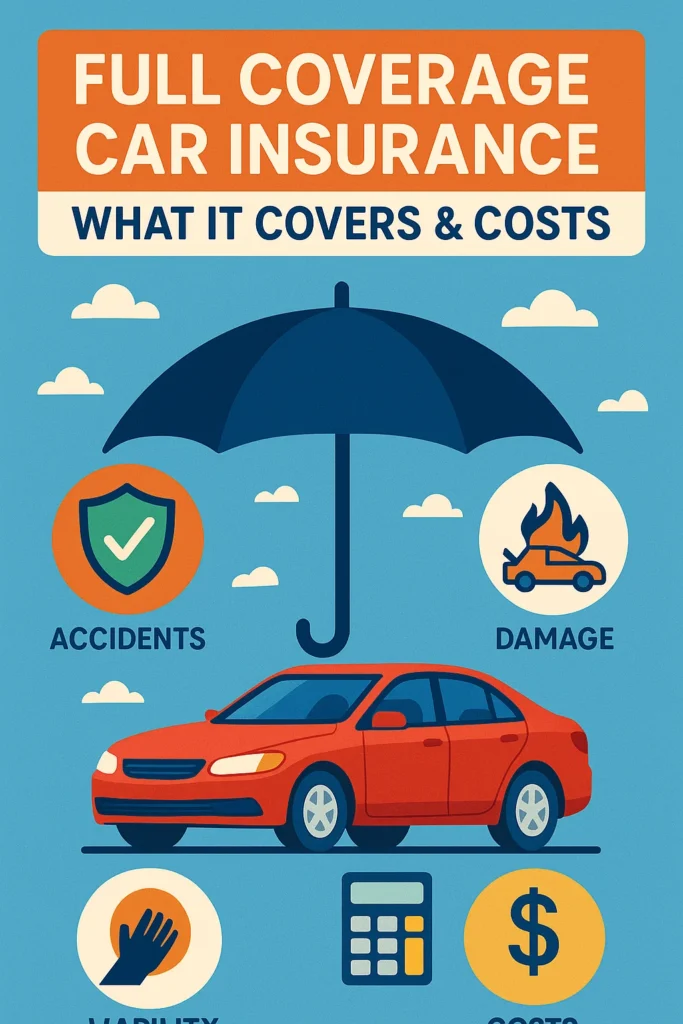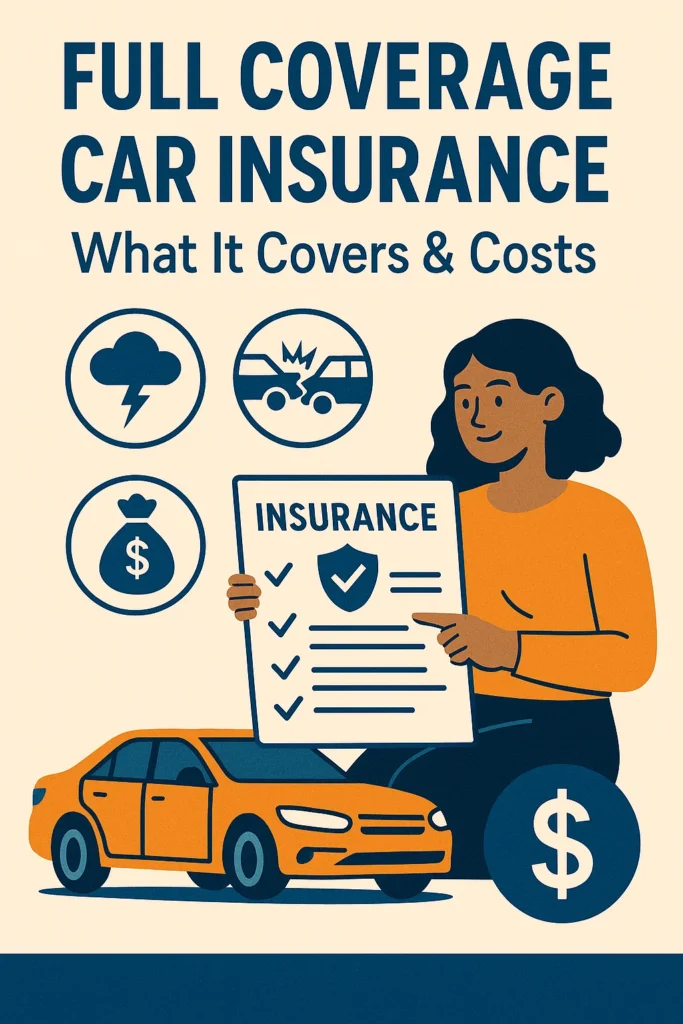Full Coverage Car Insurance: A Complete Guide for 2025
When shopping for car insurance, many drivers hear the term full coverage and assume it means total protection in every situation. While full coverage car insurance is comprehensive, it doesn’t cover “everything.” Knowing what it includes — and what it doesn’t — helps you make informed decisions.
This guide will walk you through the essentials of full coverage car insurance, from what it means to how much it costs, and when it’s worth it.
What is Full Coverage Car Insurance?
There’s no single policy officially called full coverage car insurance. Instead, it refers to a bundle of coverages that go beyond the state minimum.
A typical full coverage policy includes:
- Liability insurance (covers damages you cause to others)
- Collision insurance (covers damages to your car from accidents)
- Comprehensive insurance (covers non-collision incidents like theft, vandalism, and weather damage)
Before deciding if full coverage is right for you, it’s smart to check your car’s current value using trusted resources like the Kelley Blue Book.
What Full Coverage Doesn’t Cover
It’s a common misconception that full coverage protects against every possible expense. In reality, it does not include:
- Routine maintenance or wear and tear
- Personal belongings inside the vehicle
- Rideshare or commercial vehicle use (unless specifically added)
To get a clear understanding of what’s included in auto insurance policies, refer to the NAIC’s Auto Insurance Guide which outlines coverage types in detail.
How Much Does Full Coverage Car Insurance Cost?
The cost of full coverage car insurance depends on several factors. As of 2025, the national average is $147 per month.
Key factors affecting the price include:
- Location (rates vary by state and ZIP code)
- Vehicle value and model year
- Driver’s age and experience
- Driving history (accidents, violations)
- Credit score
- Chosen deductibles and policy limits
You can get more insights into coverage breakdowns by reviewing the Insurance Information Institute’s guide on comprehensive coverage.

Is Full Coverage Car Insurance Required?
Full coverage is not required by law. However, lenders and leasing companies often mandate it to protect their investment in the vehicle.
When is Full Coverage Recommended?
- For new or expensive cars (generally valued over $4,000)
- If the vehicle is financed or leased
- For drivers with a history of accidents or young/inexperienced drivers
- If you intend to resell the vehicle
If your car’s market value is low, it might be more cost-effective to stick with liability-only insurance.
Full Coverage vs. State Minimum Insurance
To illustrate the difference:
| Aspect | Full Coverage | State Minimum Insurance |
|---|---|---|
| Covers your own vehicle damage | ✅ (Collision & Comprehensive) | ❌ |
| Meets state legal requirements | ✅ | ✅ |
| Covers other drivers’ damages | ✅ (Liability Insurance) | ✅ |
| Covers non-collision incidents | ✅ (Comprehensive Insurance) | ❌ |
| Typically more expensive | ✅ | ✅ (cheaper but less protection) |
Cheapest Companies for Full Coverage in 2025
According to recent surveys, the most affordable providers for full coverage are:
- Travelers — ~$122/month
- American Family — ~$132/month
- USAA — ~$141/month (for military families only)
- GEICO and State Farm also offer competitive rates depending on location.
How to Find the Best Full Coverage Policy
To get the best value, you should:
- Compare quotes from multiple insurers
- Evaluate customer satisfaction and claims handling reputation
- Look into local and regional insurance companies
- Understand optional add-ons and policy customizations
Tips to Save on Full Coverage Insurance
Here are practical ways to lower your full coverage insurance premiums:
- Increase your deductible (higher deductible = lower premium)
- Bundle policies (combine auto and home insurance)
- Maintain a clean driving record
- Improve your credit score
- Enroll in safe driving programs for discounts
- Re-shop for rates annually

How Age Impacts Full Coverage Rates
Age plays a major role in how much you’ll pay for full coverage car insurance.
- Teen drivers face the highest premiums due to inexperience
- Drivers in their 30s-50s typically enjoy the best rates
- Seniors (70+) may see increases due to higher accident risk
Example: A 40-year-old might pay 50% less than a 19-year-old for identical coverage.
FAQs About Full Coverage Car Insurance
What does full coverage insurance cover?
- It includes liability, collision, and comprehensive insurance, providing protection against at-fault accidents and non-collision damages.
How much is full coverage per month?
- On average, $147/month in 2025, varying based on individual factors.
Is full coverage mandatory?
- No, but it is typically required for leased or financed vehicles.
What’s the difference between comprehensive and collision?
- Comprehensive insurance covers non-collision events (theft, vandalism), while collision insurance covers damage from accidents with other vehicles or objects.
Should you have full coverage on an older car?
- If your car is worth less than $4,000, full coverage might not be worth the extra cost.
Can you have full coverage without collision?
- No, full coverage by definition includes both collision and comprehensive insurance.
Does full coverage cover rental cars?
- Only if rental reimbursement is included in your policy.
Does full coverage include gap insurance?
- Gap insurance is a separate add-on that covers the difference between your car’s loan balance and its depreciated value after a total loss.
Final Thoughts
Full coverage car insurance is an excellent choice for those seeking maximum protection, especially for newer or financed vehicles. While it comes at a higher premium, the benefits often outweigh the costs for most drivers.
Before making a decision, always assess:
- Your car’s current value
- Your financial situation
- Your driving habits
By comparing rates and understanding your needs, you can find the best full coverage policy for your situation.